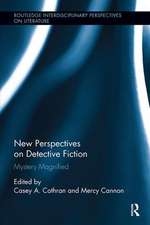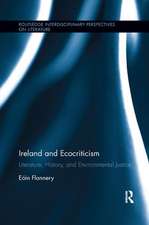James Joyce, Science, and Modernist Print Culture: “The Einstein of English Fiction”: Routledge Studies in Twentieth-Century Literature
Autor Jeffrey S. Drouinen Limba Engleză Paperback – 23 aug 2018
| Toate formatele și edițiile | Preț | Express |
|---|---|---|
| Paperback (1) | 449.41 lei 6-8 săpt. | |
| Taylor & Francis – 23 aug 2018 | 449.41 lei 6-8 săpt. | |
| Hardback (1) | 1052.35 lei 6-8 săpt. | |
| Taylor & Francis – 23 dec 2014 | 1052.35 lei 6-8 săpt. |
Din seria Routledge Studies in Twentieth-Century Literature
-
 Preț: 311.41 lei
Preț: 311.41 lei -
 Preț: 310.60 lei
Preț: 310.60 lei -
 Preț: 155.21 lei
Preț: 155.21 lei -
 Preț: 302.95 lei
Preț: 302.95 lei -
 Preț: 310.70 lei
Preț: 310.70 lei - 9%
 Preț: 1005.33 lei
Preț: 1005.33 lei - 18%
 Preț: 706.91 lei
Preț: 706.91 lei -
 Preț: 446.37 lei
Preț: 446.37 lei -
 Preț: 482.78 lei
Preț: 482.78 lei -
 Preț: 277.17 lei
Preț: 277.17 lei - 18%
 Preț: 1052.35 lei
Preț: 1052.35 lei -
 Preț: 305.67 lei
Preț: 305.67 lei - 15%
 Preț: 210.15 lei
Preț: 210.15 lei - 18%
 Preț: 1056.32 lei
Preț: 1056.32 lei - 18%
 Preț: 1058.38 lei
Preț: 1058.38 lei -
 Preț: 446.32 lei
Preț: 446.32 lei - 18%
 Preț: 999.98 lei
Preț: 999.98 lei - 18%
 Preț: 1053.16 lei
Preț: 1053.16 lei -
 Preț: 430.96 lei
Preț: 430.96 lei - 18%
 Preț: 1109.18 lei
Preț: 1109.18 lei - 18%
 Preț: 1115.33 lei
Preț: 1115.33 lei - 18%
 Preț: 1118.46 lei
Preț: 1118.46 lei - 18%
 Preț: 1115.33 lei
Preț: 1115.33 lei - 26%
 Preț: 820.73 lei
Preț: 820.73 lei - 18%
 Preț: 1060.19 lei
Preț: 1060.19 lei - 18%
 Preț: 1058.10 lei
Preț: 1058.10 lei -
 Preț: 444.51 lei
Preț: 444.51 lei - 18%
 Preț: 1056.14 lei
Preț: 1056.14 lei -
 Preț: 441.74 lei
Preț: 441.74 lei - 18%
 Preț: 1058.79 lei
Preț: 1058.79 lei - 18%
 Preț: 1057.40 lei
Preț: 1057.40 lei - 18%
 Preț: 1062.26 lei
Preț: 1062.26 lei -
 Preț: 429.23 lei
Preț: 429.23 lei -
 Preț: 463.62 lei
Preț: 463.62 lei - 18%
 Preț: 1053.92 lei
Preț: 1053.92 lei - 18%
 Preț: 1114.98 lei
Preț: 1114.98 lei - 18%
 Preț: 1163.19 lei
Preț: 1163.19 lei -
 Preț: 482.53 lei
Preț: 482.53 lei - 18%
 Preț: 1103.85 lei
Preț: 1103.85 lei -
 Preț: 415.25 lei
Preț: 415.25 lei
Preț: 449.41 lei
Nou
Puncte Express: 674
Preț estimativ în valută:
85.100€ • 91.96$ • 71.70£
85.100€ • 91.96$ • 71.70£
Carte tipărită la comandă
Livrare economică 18 aprilie-02 mai
Preluare comenzi: 021 569.72.76
Specificații
ISBN-13: 9781138378049
ISBN-10: 1138378046
Pagini: 180
Dimensiuni: 152 x 229 mm
Greutate: 0.45 kg
Ediția:1
Editura: Taylor & Francis
Colecția Routledge
Seria Routledge Studies in Twentieth-Century Literature
Locul publicării:Oxford, United Kingdom
ISBN-10: 1138378046
Pagini: 180
Dimensiuni: 152 x 229 mm
Greutate: 0.45 kg
Ediția:1
Editura: Taylor & Francis
Colecția Routledge
Seria Routledge Studies in Twentieth-Century Literature
Locul publicării:Oxford, United Kingdom
Public țintă
Postgraduate and UndergraduateCuprins
Introduction Prologue: The Pound Connection 1. Science and the Novel in the Wartime Avant-Garde, 1914-1918 2. "Wandering Rocks," Physics, The Egoist, and The Little Review, 1918-1919 3. "Ithaca," Post-Euclidean Geometry, Relativity, and the Mythic Method, 1920-1922 4. Finnegans Wake and Popular Science in the Inter-War Period, 1923-1929 Epilogue
Descriere
This book makes an important intervention in the ongoing debates about modernism, science, and the divisions of early Twentieth-Century print culture. In order to establish Joyce's place in the nexus of modernism and scientific thought, Drouin uses the methods of periodical studies and textual criticism to examine the impact of Einstein's relativity theories on the development of Ulysses (1922) and Finnegans Wake (1939). Looking at experiments with space, time, motion, and perspective, it rigorously surveys discourse of science and the novel in the print culture networks connected to Joyce, with concrete analysis of avant-garde magazines, newspapers, popular science books, BBC pamphlets, and radio broadcasts between 1914 and 1939. These sources elucidate changes that Joyce made to the manuscripts, typescripts, and page proofs of certain episodes of his final two novels. The new evidence establishes for the first time the nature of the material link between Joyce and non-technical science, and the manner in which Ulysses and Finnegans Wake owe their structure and meaning to the humanistic issues associated with science during the wartime and inter-war years. In examining the relationships between Joyce's later work and the popular science industry, the book elucidates the often conflicting attitudes toward science in inter-war British print culture, filling in a piece of the puzzle that is modernism's relationship to the new physics and, simultaneously, the history of the novel.




















